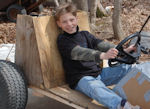In my go kart travels, I had the privilege of using both style engines the Briggs and the Tecumseh.
Just so you understand I have a background in engines, in that I worked for at least 4 years professionally, as a engine repair mechanic. So I worked on Onans, Wisconsins, Wisconsin Robins, you name it, OHV Hondas, even larger engines like Chryslers and so on, from V-8s to your very small engines. It was my job to work on them and to take them completely apart and to rebuild them. Sometimes to even bore them out. So I do have an extensive history inside of engines. So in case you were wondering, “What does this guy have for experience?” That is part of my history.
I do have a weakness in two-cycle engines: in this day and age the two cycle engines have changed. I know that there are special valves and people are experimenting with them. I have just not kept up with the times on two cycle engines. I know that they are still pushing for four-cycles because they are more fuel efficient. Whereas on a two cycle they let unburned fuel out in the exhaust port.
I had a professor at college (MSOE), that used to just for fun, run these two-cycle out board marine engines and they would light a flame on the exhaust. They would actually get a flame to come off the exhaust because there was unspent fuel coming out. (But I digress…)
I used to be a real hard core Tecumseh man, because that was my first engine that I bought for $30 from a friend. My friend had a racing go kart style engine. He had modified it by milling the head. So I just beat the snot out of the engine. And I did all sorts of changes to it. (Refer to the go kart development files you will see the history with all the things I did with engines.)
One of the things I did learn is the Tecumseh and Briggs really are not that much different, from an internals standpoint. They all have the same layout. The same kind of lifter mechanisms, but the one biggest difference is that the connecting rod for a Tecumseh used bolts that are held in with knurled heads. The knurled heads are designed to bite into the aluminum connecting rod material. You have to be very specific in how you crank down those bolts, otherwise they will walk out on you when heat comes into the equation, or vibration. And you can only crank them down to 9 foot-pounds, that typically is the torque that Tecumseh wants put on them. Well, the problem that you run into is that if you don’t do it just right you will end up actually throwing a rod, because the bolts walked out or loosened prematurely. That can be pretty frustrating. So lets say you do have a Tecumseh, one of the things that I would suggest you do is that you drill some holes in the connecting rod cap bolt heads, and then you wire the two bolts together, so they can’t loosen out, very much like a racer would wiring down his engine bolts and chassis bolts. That would be my biggest gripe about a Tecumseh.
As far as ignition is concerned Tecumseh actually has greater variance you can advance the ignition you can also by offset keys so that you can advance the ignition forward.
A Briggs is not that advanced, the ignition system is pretty much fixed. Both had their points (if they have points!) underneath the flywheel.
Now, when I was growing up the automatic ignition, electronic ignition, did not work as fast as a point system. People were not recommending using it back then because you could actually get the engine to run faster than the ignition system could handle. I am sure, now with the advent of better electronics, because that was twenty years ago, the ignition systems are much quicker and stronger. But I mainly mention this, because if you have an OLD Briggs that may be something you may want to consider if you are cranking up higher rpms. And most people are not getting up into 6000 –8000 rpms any way, so it is most likely not something for you to worry about. Besides, when you start to get up to speeds that high you need to start worrying about things blowing up and you need to have parts in the engine that can handle it. Just from an engineering and a safety standpoint I would highly dissuade you from trying to make your engine to crank really high rpms, you are going to get hurt if something flies apart. You would have to specially design you engine to handle those kind of rpms.
We are more talking about an engine from a soundness or durability standpoint. The Briggs, you could get an iron liner inside the engine bore, they called that their I/C series ( Industrial/Commercial). I would highly recommend if you have access to an I/C engine that you grab onto it. The iron liner greatly increases engine life and it allows you to give you engine more abuse, or push it to it limits more. Tecumseh’s have the same iron liner they have covered that as well.
When you are dealing with just raw aluminum walls you are going to run into problems with small engines because they cannot dissipate he heat well enough and they are not designed to run extensively with those aluminum walls.
A Briggs, like we said before, the internals of the engine the same. They are very close to being the same. Even the adjustment to the valves and the valve retainers is the same.
If you are looking for a Pros and Cons, just be aware that the Tecumseh actually tends to have lighter parts. I however like a Tecumseh from a carburetor standpoint because it is easier to work with. The only problem from a packaging situation is that Tecumseh has their gas tank mounted up high and it eats up more space, whereas a Briggs is more compact with the tank down below. Now that is why, actually, go karters prefer 5 hp style Briggs because it is more compact, more in one place. Now with the advent of the new Over Head Valve (OHV) engines the gas tanks are on top but they have done an excellent packaging job in that they have had to angle the cylinder down so that they can actually get it into the same space. So packaging consideration may be actually something that you may want to think about.
If you are a new go karter and you have access to an OHV engine, I would suggest that is the engine that you go with any way. Because OHV engines are designed to be more efficient in their combustion and they actually have more power and should be able to handle in the long run the abuse. They were literally developed. They probably have different alloys in the cylinder bores, pistons, valves etc… and they can handle longer hours of operation.


